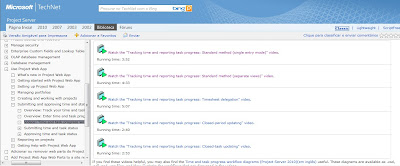SharePoint Dev - Infra
quarta-feira, 23 de novembro de 2011
Criar um KPI relatório Detalhes usando o Dashboard Designer
Para criar um KPI Detalhes relatório
1. Na faixa de opções, clique na guia Criar. Então, no grupo Relatórios, clique em Detalhes KPI. O relatório é aberto para edição.
2. No painel central, clique na guia Editor. Lá, você pode especificar as informações que você deseja exibir no relatório.
| KPI section | Option | Description |
|---|---|---|
| Cell Context Information | Show cell context information | Select this option to display the following information:
|
| Expand cell context sections by default | By default, this option is selected. It causes the KPI Details report to be expanded to display the information that you specify. | |
| Show Indicator Options | Show status graph | Do not use this option. It does not work in the current version of PerformancePoint Services. |
| Show indicator graphic | Do not use this option. It does not work in the current version of PerformancePoint Services. | |
| Show Details Information | Show actual | Select this option to display actual values when cells in the scorecard's Target column are clicked. |
| Show calculation | Select this option to display how scores are calculated and what banding method is used by the KPI that was clicked. KPIs use one of the following calculations:
| |
| Show score | Select this option to show raw scores when cells in the scorecard's Target column are clicked. | |
| Show threshold grid | Select this option to determine whether to show the threshold grid when cells in the scorecard's Target column are clicked. The threshold grid includes the following information:
| |
| For metrics with normalized weighted value, show Percentage values | Select this option to display performance in percentages in the threshold grid. | |
| For metrics with normalized weighted value, show Target values adjusted for indicator threshold percentages | Select this option to display performance in numeric values in the threshold grid. | |
| Show variance | Select this option to show the variance from the next status threshold. For example, if performance is slightly off target for a particular metric, the variance would be how far away the metric is from being on target. | |
| Additional information | Show Description | Select this option to display any text that was entered in the Description box for a KPI (visible on the Properties tab for a KPI in Dashboard Designer). |
| Show Comments | Select this option to display any comments or annotations that have been added to a scorecard. Depending on whether comments (or annotations) are enabled in the SharePoint Central Administration Web site, both dashboard authors and dashboard consumers can add comments to a scorecard.
| |
| Show KPI Properties | Select this option to display any custom properties that might have been created for each KPI (visible on the Properties tab for a KPI in Dashboard Designer). | |
| Show Person Responsible | Select this option to display information about the person who is responsible for the KPI status (which is visible on the Properties tab for a KPI in Dashboard Designer). |
sexta-feira, 18 de novembro de 2011
sábado, 6 de agosto de 2011
Get-SPScripts : PowerShell Scripts for SharePoint: Finding site template names and ID’s in SharePoint...
terça-feira, 26 de abril de 2011
Time and task progress workflow overview
Recurso incrivel no EPM 2010, vale a pena.
http://technet.microsoft.com/pt-br/library/gg609826.aspx
Até mais.
sexta-feira, 21 de janeiro de 2011
Estendendo as Propriedades de Usuário do SharePoint via BCS (Business Connectivity Services)
quarta-feira, 1 de dezembro de 2010
WebCasts por demanda de Project Server 2010
Segue uns webcasts sobre demanda para todos aproveitarem, sobre o Project Server 1010.
![]()
Demand Management overview in Project 2010 (video and white paper)
Watch a short video and download a white paper about the Demand Management capability in Microsoft Project Server 2010. Demand Management represents a deliberate attempt to reconcile and combine multiple lifecycle management tasks within a single, unified approach.
![]()
Project 2010 Quick Start Training – Demand Management
The Demand Management module of the Quick Start training covers the key components that enable the demand management functionality in Project Server 2010: Enterprise Project Types, Project workflows (Stages and Phases), Project Detail Pages, Approvals, and steps to implement your own governance process.
![]()
Portfolio Selection and analytics overview in Project 2010 (video and white paper)
Learn how new Portfolio Selection and analytical capabilities in Project Server 2010 build a bridge between value optimization and resource utilization to help organizations select project portfolios based on alignment with business strategy and resource capability.
![]()
Project 2010 Quick Start Training – Portfolio Strategy
The Portfolio Strategy module of the Quick Start training covers the process of setting up Business Drivers, aligning projects to Business Drivers, Project Prioritization, and the selection process.
Link: http://technet.microsoft.com/en-us/projectserver/ff899331.aspx


























